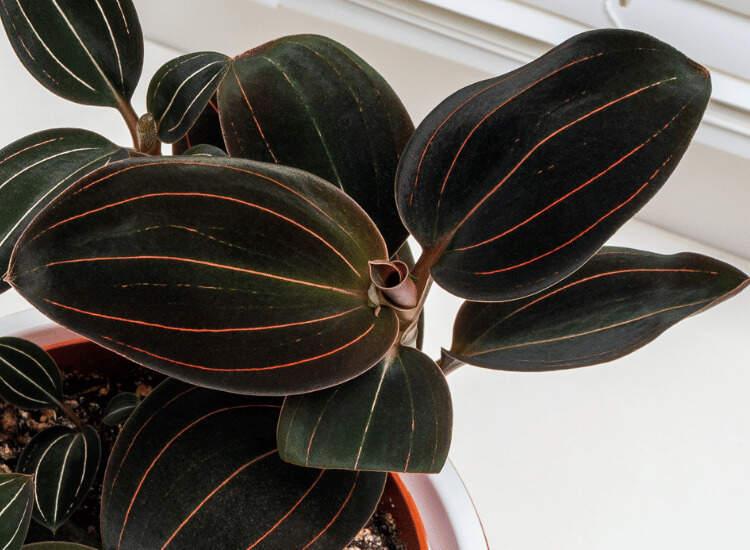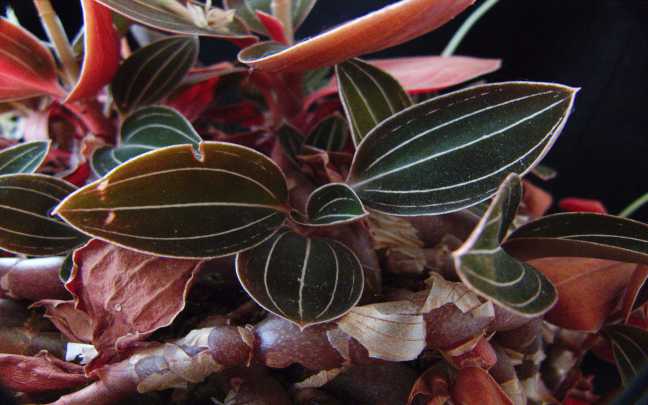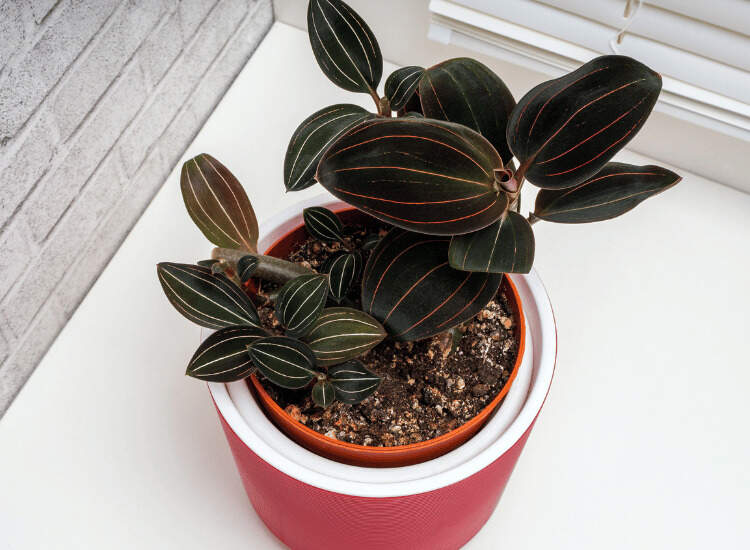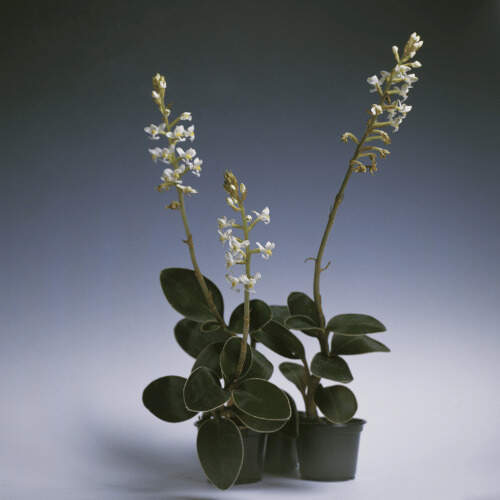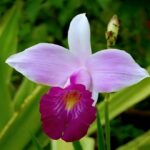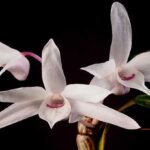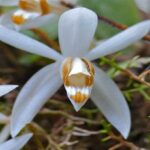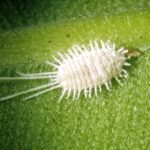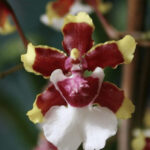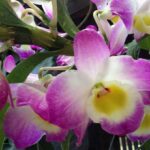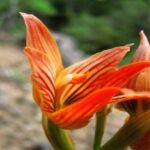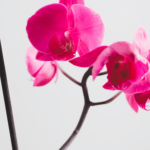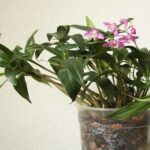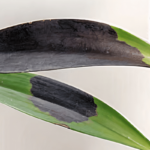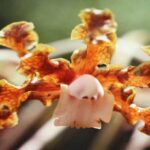Ludisia orchids are plants that stand out for the beauty of their leaves. With vibrant colors, different from the common green in other orchids.
Among the more than 30,000 orchid species, Ludisia are unique for having leaves as their main attraction.
While in other orchids, such as Cattleyas, Phalaenopsis, or Vanda, flowers are the main focus, Ludisia is known for the beauty of its leaves.
Popularly known as jewel orchids, besides their beauty, Ludisia orchids are also easy to cultivate.
They are ground orchids (terrestrial orchids), which means they grow in the soil, not on trees. This makes them more resistant and easy to care for, making them a great option for beginner growers.
In this article, we will learn more about Ludisia orchids, including their characteristics, curiosities, and how to take care of them.
Their Leaves
The leaves of the Ludisia orchid are its main feature.
They are velvety, shiny, and have vibrant colors, especially ranging from green to dark red.
On the upper side, the leaves are green with light or coppery veins. On the lower side, they are wine-colored. The contrast between the two colors is what makes Ludisia leaves so unique and attractive.
The leaves of Ludisia have an oval or elliptical shape.
Even when not in bloom, the jewel orchid is a very beautiful ornamental plant.
It is important to note that there are varieties of Ludisia discolor (the main species of the Ludisia genus) where the color of the leaves is slightly different.
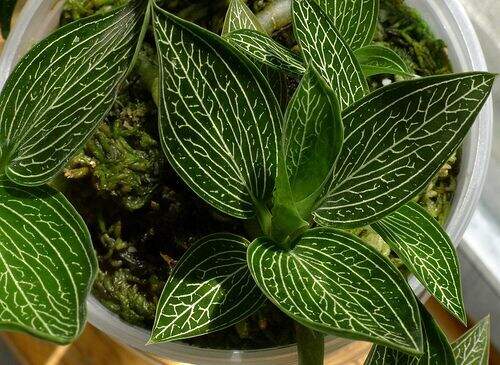
Here are 2 of the most popular varieties:
- Ludisia discolor var. discolor – the most common variant.
- Ludisia discolor var. Alba – green leaves with white veins
There are also other varieties, for example:
- Ludisia discolor var. nigricans
- Ludisia discolor var. dawsoniana
- Ludisia discolor var. Jewelyana
These varieties are obtained through hybridization or mutation.
Usually, you will find for sale only the most famous variant, Ludisia discolor var. discolor.
Their Flowers
The jewel orchid’s flowers are small and delicate, with white petals and a yellow center.
The flowering of Ludisia can produce dozens of flowers and last for more than a month. The flowers emerge from elongated stems that can reach 40 centimeters in height.
Some people prefer to cut the flower stems when they start to develop, as they feel they do not match the plant’s foliage. If you choose to do so, remember to use sterilized tools.
Ludisia flowers are a beautiful complement to the plant, and if you want to learn how to cultivate it and stimulate its flowering, keep reading.
How to Care for Ludisia
Just like Paphiopedilum, the jewel orchid is a terrestrial plant and has high resistance, so it is considered easy to cultivate and can be a great option for beginners in the world of orchids.
Although extremely beautiful, these plants are not very famous outside of Asia, so depending on the country or region where you live, you may need to buy a plant online or travel a long distance to find one for sale.
Below, you will learn the 7 steps you should follow to keep your Ludisia beautiful and healthy every year.
1 – Watering and Humidity
Jewel orchids are tropical plants that need moderate to high humidity to thrive. Watering and humidity are two of the most important factors for the successful cultivation of these plants.
Ludisia should be watered when the potting mix dries out.
To find out if the potting mix is dry, just sink your finger 1 inch into the pot and check if the soil is still moist. If it is dry, you can water your orchid.
When watering, thoroughly wet your plant until the water drains out of the bottom of the pot.
- Beware of overwatering: If you water your orchid more frequently than ideal, it can cause various problems, such as yellow leaves, loss of buds or flowers, and root rot.
- Underwatering: Underwatering typically results in dry, shriveled leaves.
The ideal humidity for Ludisia is 60% to 80%.
If you are growing your plant indoors, you can increase humidity by placing it in a container with wet clay pebbles or placing it on a tray of water. You can also use a humidifier to increase the air humidity in your home.
Very low humidity can cause darkening of leaf tips and stunted flowers.
2 – Lighting
The vast majority of orchids prefer indirect light since in nature, they grow on the ground or hanging on trees, where they are protected from direct sunlight. This also happens with jewel orchids.
Direct sunlight can burn the tips of your Ludisia’s leaves, so it is important to place it in a location where it receives filtered light.
Some growers let the jewel orchid receive direct sunlight for about 2 hours, during the morning period when the sun is weaker.
- If your Ludisia is not receiving enough light, it can start to elongate, meaning its leaves will become thin and long.
- If your Ludisia is receiving too much light, the tips of the leaves can turn brown or yellow.
3 – Temperature
Ludisia orchids prefer warm and humid temperatures. The ideal temperature for cultivation is 12°C to 25°C (54°F to 78°F).
They are sensitive to cold and do not tolerate temperatures below 10°C (50°F). If the temperature drops below this range, the plant’s leaves can turn yellow and fall off. In severe cases, the plant can die.
Excessive heat can also cause issues; temperatures above 30°C (86°F) can stress the plant.
Furthermore, Ludisia orchids are sensitive to temperature variations.
Large temperature changes can stress the plant. So, if you are moving your plant, be careful not to change the climate too much.
To keep your Ludisia orchid healthy, it is important to maintain the room temperature between 12°C and 25°C (54°F and 78°F) and avoid exposing the plant to cold or hot drafts.
- If you live in a region with cold winters, you may need to move your Ludisia orchid indoors during winter.
- If you live in a region with hot summers, you may need to place your Ludisia orchid in a shadier spot during the day.
Some other notes about the ideal temperature for the jewel orchid include:
- The longer your orchid is exposed to extreme temperatures, the greater the damage.
- The ideal temperature for growing Ludisia orchids varies slightly depending on the variety of your plant. Some species tolerate colder or hotter temperatures than others.
- You can use a thermometer to measure the room temperature where your orchid is growing.
4 – Potting Mix
Ludisia orchids are terrestrial plants that prefer a potting mix rich in organic material that retains moisture but also allows good drainage.
Therefore, you can use a basic potting mix for them, usually a mixture of peat compost, perlite, and vermiculite.
Peat provides organic material, perlite aids in drainage, and vermiculite helps retain moisture.
Other options of potting mixes rich in organic material can also be a great choice for your jewel orchid.
It is important to note that potting mixes made for orchids that you find for sale in orchid nurseries are not recommended for this species, as they have large volumes of bark and are made for epiphytic orchids, not terrestrial orchids.
The jewel orchid should not be planted in orchid bark or any other loose potting mix.
5 – Fertilizer
In nature, orchids obtain their “fertilizer” from organic materials (for example, leaves) that fall near where they are planted or hanging.
When cultivating an orchid, we need to fertilize the plant so that it has energy to develop and bloom.
In the jewel orchid, we can use chemical or organic fertilizers.
Basically:
- Chemical fertilizers: you can use balanced fertilizers, for example, NPK 20 20 20 or NPK 10 10 10.
- Organic fertilizers: a great option is bokashi. It provides the plant with a variety of nutrients, including nitrogen, phosphorus, potassium, calcium, magnesium, and iron.
Chemical fertilizers should be diluted according to the package instructions. Over-fertilizing your Ludisia orchid can cause root burns.
When fertilizing, follow the instructions on your fertilizer package.
6 – Repotting
Repotting Ludisia occurs on average every two to three years or when the roots start to come out of the pot.
The best time to repot is in spring when the plant is actively growing, and avoid repotting if it is flowering. Some signs that a Ludisia orchid needs to be repoted include:
- Leaves falling off
- Roots starting to come out of the pot
- Compact soil
To repot your Ludisia orchid, follow these steps:
- Choose a new pot: the jewel orchid spreads horizontally, so its roots are not very deep. In this case, it is ideal to choose a pot that is shallow and wide. Terracotta or plastic pots are great options.
- Fill this new pot with the chosen potting mix
- Remove your orchid from the old pot, clean its roots
- Trim dead or rotten roots
- Place your orchid in the new pot, make sure it is secure and does not have the risk of falling.
When cutting your orchid’s roots, remember to use sterilized scissors.
7 – Multiplication
Multiplication of Ludisia orchids can be done by stem cuttings or rhizome division:
Stem Cuttings
This is the simplest and most effective method of multiplying Ludisia orchids. To make a stem cutting, follow these steps:
- Choose a healthy and vigorous stem at least 8 cm long.
- Make a cut just below a node on the stem.
- Remove all leaves from the stem below the node.
- Plant the cutting in a pot with orchid potting mix.
- Keep the soil moist but not waterlogged.
- Stem cuttings usually start rooting in a few weeks. Once the roots have grown, you can transplant the new plant into a larger pot.
Rhizome Division
Division is another effective method of multiplying Ludisia orchids. To divide a Ludisia orchid, follow these steps:
- Remove the orchid from the pot.
- Use sterilized scissors to cut the rhizome into two or three sections.
- Each section should have at least one pseudobulb and roots.
- Plant each section in a pot with orchid potting mix.
- Divided plants usually start growing in a few weeks.
Ludisia orchids can be multiplied throughout the year, but the best time is during spring or summer when the plant is actively growing. Other Important Tips:
- Stem cuttings in water: You can also root Ludisia orchid stem cuttings in water. To do this, place the cutting in a glass of clean water and change the water regularly. Roots usually start growing in a few weeks.
- Rhizome: The rhizome is the underground structure of the Ludisia orchid. It is composed of pseudobulbs, which are structures that store water and nutrients. To divide a Ludisia orchid by the rhizome, use sterilized scissors to cut the rhizome into two or three sections. Each section should have at least one pseudobulb and roots.
Characteristics and Curiosities of Jewel Orchid
Ludisia is a genus of orchids that for a long time had only one species, Ludisia discolor.
This species was described in 1818 as Goodyera discolor by John Ker-Gawler and updated to Ludisia discolor in 1825 by Achille Richard. In 2013, the Ludisia genus gained a new species called Ludisia ravani.
Ludisia orchids, also known as jewel orchids, are terrestrial tropical plants native to the humid forests of Asia, especially found in China and Malaysia.
This orchid does not have pseudobulbs and has rhizomes; therefore, the growth presented by these plants is sympodial. Their growth is slow and typically does not exceed 40 to 60 centimeters in height.
The leaves of Ludisia orchids are fleshy and shiny and can be green, black, brown, or have colorful spots. The flowers are small and white, located at the base of the plant.
Ludisia discolor is not toxic to pets (source); unfortunately, I could not find information about the toxicity of Ludisia ravani.
Besides the Ludisia genus species, there are also two other orchids popularly known as “jewel orchids”:
- Macodes petola, which has leaves with red spots
- Orchids of the Anoectochilus genus, which have leaves with green and white spots.
Conclusion – Ludisia Orchids
This was a quick guide on how to cultivate Ludisia orchids. If you want to learn more about orchid cultivation, you can access one of these articles below:
- Renanthera Orchids
- Phragmipedium Orchids
- 22 Brazilian Orchids You Probably Don’t Know
- How to Care for Orchids
Now it’s your turn, leave your comment below sharing your experiences with Ludisia discolor orchids.

